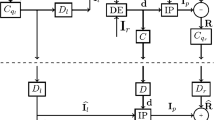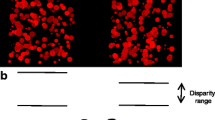Abstract
3D applications are very popular nowadays. They allow to bring new sensations (e.g., cinema, gaming, etc) and new ways for analyzing data (e.g., video-surveillance, pattern recognition, etc). The large availability of 3D data ia better understanding of human 3D perception in order to improve the quality of 3D visual data, increase the visual comfort and avoid visual fatigue and visual illness. In this paper, we explore the binocular perception through its various indices. The focus is put on the binocular energy and its evolution with regard to image impairments. Two types of cells are explored, that is, simple and complex cells responsible of the sensory fusion in the visual cortex. A model is proposed for these cells in order to estimate the binocular energy from color stereo-pairs. The integration of stereoscopic constraints such as unicity, coherence and occlusion allows to refine the proposed model described previously by taking into account the occluded and the non-occluded information. A deep experimentation demonstrates the efficiency of the described modeling. The estimated binocular energy presents a correlation with the impairment level caused by compression or noise.

















Similar content being viewed by others
Explore related subjects
Discover the latest articles, news and stories from top researchers in related subjects.References
Adelson EH, Bergen JR. Spatiotemporal energy models for the perception of motion. J Opt Soc Am. 1985;2(2):284–99.
Akhter R, Sazzad ZMP, Horita Y, Baltes J. No reference stereoscopic image quality assessment. Image Qual Syst Perform. 2010;7524:17–21.
Anderson BL. The role of partial occlusion in stereopsis. Nature. 1994;367(6461):365–68.
Ates HF, Orchard MT. A nonlinear image representation in wavelet domain using complex signals with single quadrant spectrum. In: Asilomar conference signals, systems, computers, vol 2. 2003;pp. 1966–70.
Barlow HB, Blakemore C, Pettigrew JD. The neural mechanism of binocular depth discrimination. J Physiol. 1967;193:327–42
Blake R, Wilson HR. Neural models of stereoscopic vision. Trends in neurosciences. Int J Comput Vis. 1991;14:445–52.
Campbell FW, Cooper GF, Enroth-Cugell C. The spatial selectivity of the visual cells of the cat. J Physiol. 1969;203:223–35.
Candès E, Demanet L, Donoho D, Ying L. Fast discrete curvelet transforms. Multiscale Model Simul. 2005;5(3):861–99.
Chessa M, Canessa A, Gibaldi A, Solari F, Sabatini S. Embedding fixation constraints into binocular energy-based models of depth perception. In: International conference on cognitive and neural systems. Boston, Massachusetts; 2009.
Christen WG, Mower DG. Effects of monocular occlusion and diffusion on visual system development in the cat. Brain Res. 1987;415(2):233–41.
DeAngelis GC, Ohzawa I, Freeman RD. Depth is encoded in the visual cortex by a specialized receptive field structure. J Nat. 1991;352:156–59.
Delorme A, Fluckiger M. Perception et réalité, une introduction à la psychologie des perceptions. Brussels: De Boeck; 2003.
Do M, Vetterli M. Pyramidal directional filter banks and curvelets. In: IEEE proceedings of the international conference image; 2001.
Donoho DL. Wedgelets: nearly-minimax estimation of edges, annals of stat. Commun Pure Appl Math. 1999;27(3):859–97.
Fleet DJ, Wagner H, Heeger DJ. Disparity from local weighted phase-correlation. In: Proceedings of the IEEE international conference on systems. Man, Cybernetics; 1994. p. 48–56.
Fleet DJ, Wagner H, Heeger DJ. Neural encoding of binocular disparity: energy model, position shifts and phase shifts. Vis Res. 1996;36(12):1839–857.
Foster KH, Gaska JP, Marcelja S, Pollen DA. Phase relationships between adjacent simple cells in the feline visual cortex. J Physiol. 1983;345:22.
Geiger D, Ladendorf B, Yuille A. Occlusions and binocular stereo. Int J Comput Vis. 1995;14:211–26.
Geman S, Geman D. Stochastic relaxation, gibbs distributions and the bayesian restoration of images. IEEE Trans Pattern Anal Mach Intell. 1984;6(6):721–41.
Grossberg S. 3d vision and figure ground separation by visual cortex. Percept Psychophys. 1994;55(1): 48–120.
Grossberg S, McLoughlin PN. Cortical dynamics of three-dimensional surface perception: binocular and half-occluded scenic images. Trans Soc Comput Simul Int. 1997;14:583–1605.
Hayashi R, Maeda T, Shimojo S, Tachi S. An integrative model of binocular vision: a stereo model utilizing interocularly unpaired points produces both depth and binocular rivalry. Vis Res. 2004;44(20):2367–380.
Haynes JD, Deichmann R, Rees G. Eye-specific effects of binocular rivalry in the human lateral geniculate nucleus. J Nat. 2005;438(7067):496–99.
Hibbard PB. Binocular energy responses to natural images. Vis Res. 2008;48(12):1427–439.
Horaud R, Monga O. Vision par ordinateur: outils fondamentaux. Paris: Editions Hermès; 1995. p. 426. ISBN:978-2866014810.
Howard IP, Rogers BJ. Depth perception. Oxford: Oxford Scholarship; 2008.
Hubel D, Wiesel TN. Receptive fields, binocular interaction and functional architecture in the cat’s visual cortex. J Physiol. 1962;160:106–54.
Hubel D, Wiesel TN. Stereoscopic vision in macaque monkey. Cells sensitive to binocular depth in area 18 of the macaque monkey cortex. J Nat. 1970;225:41–2.
Jones JP, Palmer LA. An evaluation of the two-dimensional gabor filter model of simple receptive fields in cat striate cortex. J Neurophysiol. 1987;58(6):1233–258.
Kingsbury N. Image processing with complex wavelets. Phil Trans Royal Soc Lond A. 1997;357:2543–560.
Kuffler SW. Discharge patterns and functional organization of mammalian retina. J Physiol. 1953;16:37–68.
Lehky SR, Maunsell JH. No binocular rivalry in the lgn of alert macaque monkeys. Vis Res. 1996;36(9):1225–234.
Liu A, Gaska JP, Jacobson LD, Pollen DA. Interneuronal interaction between members of quadrature phase and anti-phase pairs in the cat’s visual cortex. Vis Res. 1992;32(1193–198).
Mallat S. A theory for multiresolution signal decomposition : the wavelet representation. IEEE Trans Pattern Anal Mach Intell. 1989;11(7):674–93.
Mallat S, Peyrè G. Bandelet image approximation and compression. SIAM Multiscale Model Simul. 2005;4(3):992–1039.
Mallat S, Peyrè G. Orthogonal bandelet bases for geometric image approximation. Commun Pure Appl Math. 2006;61(9):1173–212.
Marr D, Poggio T. A computational theory of human stereo vision. Proc Royal Soc Lond Ser B Biol Sci. 1979;204(1156):301–28.
McLoughlin NP, Grossberg S. Cortical computation of stereo disparity. Vis Res. 1998;38(1):91–9.
Nakayama K, Shimojo S. Da vinci stereopsis: depth and subjective occluding contours from unpaired image points. Neural Netw. 1990;30:1811–25.
Nasrabadi MN, Clifford SP, Liu Y. Integration of stereo vision and optical flow by using an energy-minimization approach. J Opt Soc Am. 1989;6(6):900–7.
Ohzawa I, DeAngelis G, Freeman R. Stereoscopic depth discrimination in the visual cortex: neurons ideally suited as disparity detectors. Science. 1990;249:1037–41.
Ohzawa I, Freeman R. The binocular organization of complex cells in the cat’s visual cortex. J Neurophysiol. 1986;56: 243–59.
Ohzawa I, Freeman R. The binocular organization of simple cells in the cat’s visual cortex. J Neurophysiol. 1986;56: 221–42.
Palmer L, Davis T. Receptive-field structure in cat striate cortex. Vis Res. 1981;46:260–76.
Pollen D, Ronner S. Phase relationships between adjacent simple cells in the visual cortex. Science. 1981;212:1409–11.
Rock I. La perception. Brussels: De Boeck; 2001.
Schanda J. Colorimetry: understanding the CIE system. Hoboken, NJ: Wiley; 2007.
Selesnick IW, Baraniuk RG, Kingsbury NG. The dual-tree complex wavelet transform. IEEE signal processing magazine; 2005. pp. 123–51.
Shimojo S, Nakayama K. Real world occlusion constraints and binocular disparity. Vis Res. 1990;30(1):69–80.
Watanabe O, Fukushima K. Stereo algorithm that extracts a depth cue from interocularly unpaired points. Neural Netw (1999);12:569–78.
Yasui S. On the square root intensity coding at the level of cone photoreceptors. Vis Res. 1992);32(1):199–202.
Author information
Authors and Affiliations
Corresponding author
Rights and permissions
About this article
Cite this article
Bensalma, R., Larabi, MC. Binocular Energy Estimation Based on Properties of the Human Visual System. Cogn Comput 5, 589–609 (2013). https://doi.org/10.1007/s12559-012-9187-7
Received:
Accepted:
Published:
Issue Date:
DOI: https://doi.org/10.1007/s12559-012-9187-7




